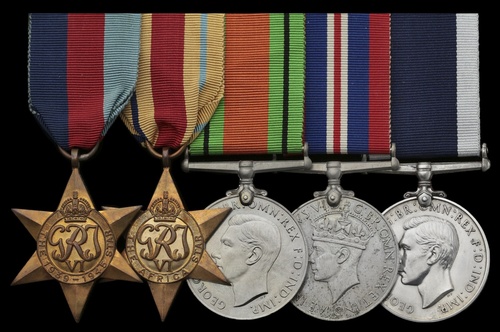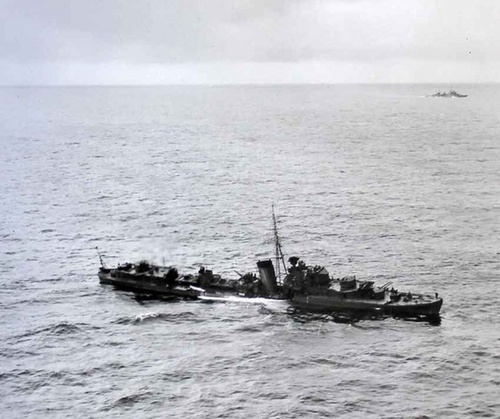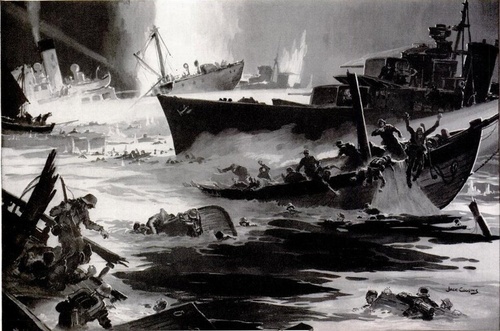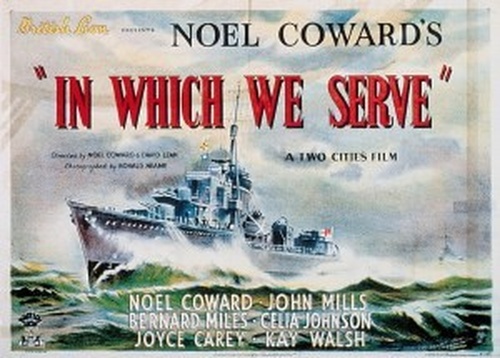Auction: 22003 - Orders, Decorations and Medals
Lot: 391
MAY 1941: CRETE
'On 20 May 1941, 16,000 German airborne troops launched the invasion of Crete, Hitler's final operation to reverse the disaster of Mussolini's attempt to occupy Greece on behalf of the Axis powers. On the following day, H.M.S. Kelly was ordered from Malta to Crete as leader of a flotilla of three K Class destroyers, to defend the island from the invasion fleet.
Early on the morning of 23 May, the flotilla was attacked by 24 Stuka dive-bombers. The ships in the flotilla took evasive action and the destroyers were sailing at full speed, about 30 knots, when both Kelly and her sister ship, H.M.S. Kashmir, were hit.
H.M.S. Kelly was struck by a large bomb, listed to port and capsized. The third ship in the flotilla, H.M.S. Kipling, managed to pick up survivors despite coming under sustained attack herself. 159 survivors of H.M.S. Kelly were rescued and taken to Alexandria.
The captain of H.M.S. Kelly and the leader of the flotilla was Lord Louis Mountbatten, the king's cousin. Mountbatten was only in his early 40s but was tall, striking, and had a natural aura of leadership and authority. Despite this, he had not enjoyed a distinguished record as captain of H.M.S. Kelly, the ship having been put out of action by mines and torpedoes three times during the war, and having in one fourteen month period spent only two weeks on active duty. Without doubt, however, Mountbatten was a popular captain much liked by the men who served under him.
Mountbatten returned to London in June 1941, where he met an old showbiz friend for lunch, Noel Coward. Mountbatten had enjoyed an interest in stage and screen throughout his life. On his honeymoon in 1922 he had visited Hollywood and appeared in a short film made by Charlie Chaplin.
Coward was gripped by Mountbatten's account of his recent experiences on H.M.S. Kelly and was particularly fascinated by the speeches he had made as captain to his crew … so he decided to make a film based on the story of Mountbatten and the H.M.S. Kelly incident. He would write it, produce it, compose the music for it - and star in it as the captain of the ship … '
The hugely popular wartime film 'In Which We Serve' was the result; 'The Military History Matters' website, refers.
An outstanding Second World War campaign group of five awarded to Electrical Artificer 1st Class A. G. Leach, Royal Navy, who served in H.M.S. Kelly, Lord Louis Mountbatten's famous command, from her commissioning until her demise in May 1941
He was twice wounded in the same period, on the first occasion in May 1940, when the Kelly was severely damaged by an E-Boat torpedo strike in the North Sea, and secondly in May 1941, when she fell victim to enemy dive bombers on returning from Crete
Tragically, having surviving Kelly's trials and tribulations, Leach met an untimely death from 'bullet wounds' received at the shore establishment H.M.S. Moreta, at Haifa, Palestine, in January 1943
1939-45 Star; Africa Star; Defence and War Medals 1939-45; Royal Navy L.S. & G.C., G.VI.R., 1st issue (MX. 46599 A. G. Leach, E.A. 1, H.M.S. Moreta), good very fine or better (5)
Alfred George Leach was born at Wareham, Dorset on 1 September 1901 and, after working as a turner and fitter, entered the Royal Navy as an Electrical Artificer 4th Class in July 1927; an entry on the Ancestry.com website states that he was among those 'who rallied at Cable Street in East London, to force back the march of the fascist Oswald Mosley and his black shirts', on 4 October 1936.
Having then been advanced to Electrical Artificer 1st Class, he was serving in H.M.S. Kelly on the outbreak of hostilities in September 1939.
Norway and the North Sea 1940 - first wound
The command of the dashing Lord Louis Mountbatten, C.O. of the Fifth Destroyer Flotilla, Kelly quickly saw action, participating in the evacuation of British troops from Namsos in Norway in April 1940 - she came under sustained air attack from dive-bombers but returned safely to Scapa Flow.
On the night of 9 May 1940, however, she was involved in a night battle with E-boats in the North Sea, being torpedoed in the boiler room and very nearly sunk. Despite the loss of all electrical power and further air attacks, Kelly was taken in tow by H.M.S. Bulldog and, later still, by the tug Watermeyer. She finally reached Tyneside after a 90-hour ordeal; among the resultant casualties was Alfred Leach, with a fractured rib.
For spectacular footage of that ordeal, see:
https://www.youtube.com/watch?v=pQj761Jo47k
After extensive repairs - almost amounting to reconstruction - Kelly was recommissioned at the end of the year and spent the first three months of 1941 patrolling the Western Approaches. She spent a great deal of time at sea off the French coast and was bombed on several occasions, including while in Plymouth harbour; she was also visited by Lord Mountbatten's cousin, King George VI.
Crete 1941 - second wound
In April 1941, Kelly sailed for the Mediterranean, and for three weeks was based at Malta, patrolling between the embattled island and the North African coast.
On 21 May 1941, she was directed to Crete to assist Commonwealth forces defending the island against the German invasion. That evening, she encountered and sank two small German troopships, and bombarded Maleme aerodrome, enabling the New Zealanders to mount a successful counter-attack. It was on this date that Leach was granted his second Hurts & Wounds certificate; his service record refers.
Kelly and Kashmir then turned for Alexandria but, shortly after dawn on the 23rd, both ships were bombed and sunk by German dive-bombers. Kashmir was lost first - physically torn apart by a 1,000lb bomb.
The Stukas then concentrated on Kelly. One bomb smashed X Turret, continued through the ship and finally detonated just aft of the engine room. The ship capsized in around a minute, trapping many men below decks. The propellers were still turning as her upturned hull bobbed on the surface for upwards of half an hour.
As the survivors awaited their consort Kipling to pick them up, the Germans strafed the life rafts in the otherwise calm Mediterranean.
In total, 80 men were lost in the Kashmir and 131 in the Kelly, but Mountbatten and Leach were among those picked up by Kipling.
Journey's end
Leach tragically succumbed to 'bullet wounds' whilst based at H.M.S. Moreta, the Haifa shore base, on 24 January 1943. Three days later a Board of Enquiry was convened, the verdict of which remains unknown.
His L.S. & G.C. Medal was subsequently issued to his next-of-kin in April of the same year.
Postscript
As cited above, Mountbatten met Noel Coward on his return to the U.K. in July 1941, from which encounter emerged the latter's idea for a propaganda film:
'To make a film based on the Kelly story would require the support of the Admiralty. And here was a problem. The Royal Navy was not keen to see the making of a popular film that centred on the sinking of one of its warships. The Ministry of Information further argued that it would be disastrous if the film was ever shown abroad as it would undermine confidence in the Navy.
Mountbatten had a more sophisticated view on the role of the film and could see how Coward's approach would be good propaganda for the Navy and a major morale booster at a bad time in the war. He launched a charm offensive. He introduced Noel Coward to Sir Dudley Pound, the First Sea Lord, and to Brendan Bracken, the Minister of Information. Under pressure from Mountbatten and Coward, the authorities came around.
Coward began production on his new film in early 1942. By this time Churchill had made Mountbatten head of Combined Operations - a considerable promotion. Despite the immense pressure of his workload, Mountbatten somehow found time to be closely involved with the production of Coward's film … ' ('The Military History Matters' website, refers).
In fact, for the speech at the end of the film, when Noel Coward - as 'Captain Kinross' - addressed the survivors of 'H.M.S. Torrin', he used the real speech that Mountbatten gave to surviving members of the Kelly.
Subject to 20% VAT on Buyer’s Premium. For more information please view Terms and Conditions for Buyers.
Sold for
£300
Starting price
£300











